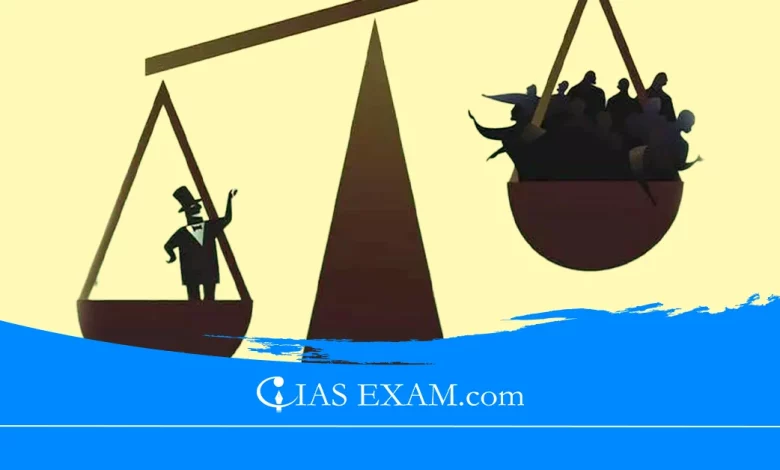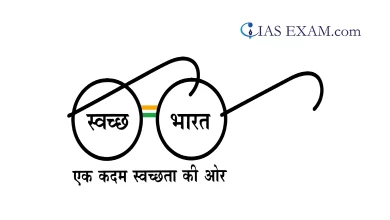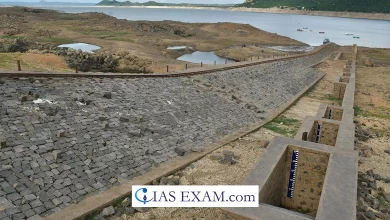Income and Wealth Inequality in India’ Report & its Findings
GS Paper 3 - Indian Economy, Inclusive Growth

Context
As per the recent reports released by the ‘World Inequality Lab’ titled ‘Income & Wealth Inequality in India’, the country’s top 1% income and wealth shares (22.6% and 40.1%) are at their highest historical levels in 2022-’23 and the country’s top 1% income share is among the very highest in the world. Cut to 1951, their share in the income was only 11.5% and even lower in the 1980s just before India opened-up its economy at 6%.
Key Findings of the Report
- Increase in Share of Top 10%: The share of the top 10% of Indians in national income rose from 36.7% in 1951 to 57.7% in 2022.
- Decline in Share of Bottom 50%: The bottom 50% of Indians earned only 15% of the national income in 2022, compared to 20.6% in 1951, indicating a decrease in their share.
- Decrease in Share of Middle 40%: The middle 40% of Indians experienced a significant decline in their share of income from 42.8% to 27.3% over the period.
- Rapid Widening of Income Gap: The gap between the rich and the poor has widened rapidly in the last two decades.
- Historic Peak for Wealthiest 1%: In 2022, the share of national income that went to the wealthiest 1% of Indians reached a historic peak, surpassing levels observed in developed countries such as the United States and the United Kingdom.
Income group-wise share in national income, and the adult population in each bracket as of 2022-23
- Distribution Across Income Percentiles: Approximately one crore adults were in the top 1%, ten crore in the top 10%, 36 crore in the middle 40%, and 46 crore were in the bottom 50% of the income pyramid.
- Concentration of Wealth at the Top: The top 0.001% of the income pyramid, comprising about 10,000 richest Indians, earned 2.1% of the national income, highlighting extreme wealth concentration.
- High Shares of National Income: The top 0.01% and top 0.1% of income earners earned disproportionately high shares of the national income, accounting for 4.3% and 9.6%, respectively. This reflects significant income inequality, with a small segment capturing a large portion of the country’s wealth.
The year wise share of national income for the top 10%, bottom 50% and that middle 40% of the population:
- 1950s-60s: Negligible income gap between the top 10% and the middle 40% of earners.
- 1980s: Bottom 50% saw a slight increase in their share of national income, contributing to narrowing the gap.
- 1990s Onwards (Post-liberalization): The income share of the top 10% surged dramatically, while shares of the other two groups steadily declined. This trend persisted into the 2000s and early 2010s, stabilizing thereafter.
- In 2022: the top 1% of earners had a higher share of national income than the richest 1% during colonial rule.
- Income Disparities: The average annual income of the top 1% was ₹53 lakh, 23 times more than the average Indian’s income of ₹2.3 lakh in 2022-23. The average income of the bottom 50% and middle 40% stood at ₹71,000 and ₹1.65 lakh, respectively, during the same period.
Reasons behind Income Inequality in India
- Historical Factors: Historical disparities in wealth distribution, exacerbated by colonial rule and feudal systems, have contributed to persistent income inequality.
- Economic Growth Patterns: India’s economic growth needs to be more inclusive, with benefits disproportionately accruing to certain segments of society, particularly urban and educated populations. This uneven growth exacerbates income inequality.
- Structural Issues: Structural factors such as unequal access to education, healthcare, and employment opportunities perpetuate income disparities. Marginalized groups such as Dalits, Adivasis, and women often face barriers to accessing quality education and formal employment, limiting their income-earning potential.
- Land Ownership and Agriculture: Unequal distribution of land ownership and disparities in agricultural productivity contribute to income inequality, particularly in rural areas where agriculture remains a primary source of livelihood.
- Labor Market Dynamics: Informal employment, low wages, and lack of job security in the informal sector contribute to income inequality. Additionally, skill mismatches and technological advancements may widen the income gap by favoring skilled workers over unskilled laborers.
- Lack of Financial Inclusion: Limited access to formal financial services and lack of asset ownership, such as land or property, among marginalized communities further perpetuate income inequality.
Measures to be Taken
- Progressive taxation reforms must be instituted to redistribute wealth more equitably across society. Implementing higher tax rates on the affluent, coupled with targeted tax incentives for low-income earners, can serve as a mechanism to bridge the wealth gap.
- Furthermore, investing in education and skill development initiatives is crucial to empower marginalized communities and bridge the educational divide. By prioritizing accessible and quality education, particularly in underserved regions, India can equip its workforce with the necessary skills to compete in an increasingly globalized economy.
- Vocational training programs should be expanded to cater to diverse skill sets, thereby enhancing employability and income potential for individuals across the socio-economic spectrum.
- Social welfare programs must be strengthened to provide a safety net for the most vulnerable segments of society. Targeted interventions such as universal healthcare coverage, subsidized food distribution, and employment guarantee schemes can mitigate the adverse effects of income inequality, ensuring basic needs are met for all citizens.
Way Forward
The recent findings from the ‘World Inequality Lab’ paint a stark picture of income and wealth inequality in India, with the top 1% holding a disproportionate share of both income and wealth. The trajectory from historical lows in the mid-20th century to current peaks underscores the urgency of addressing this disparity. The time to confront income inequality head-on is now, as it not only undermines socio-economic stability but also erodes the very fabric of democracy and inclusive growth.
SOURCE: The Indian Express





.png)



